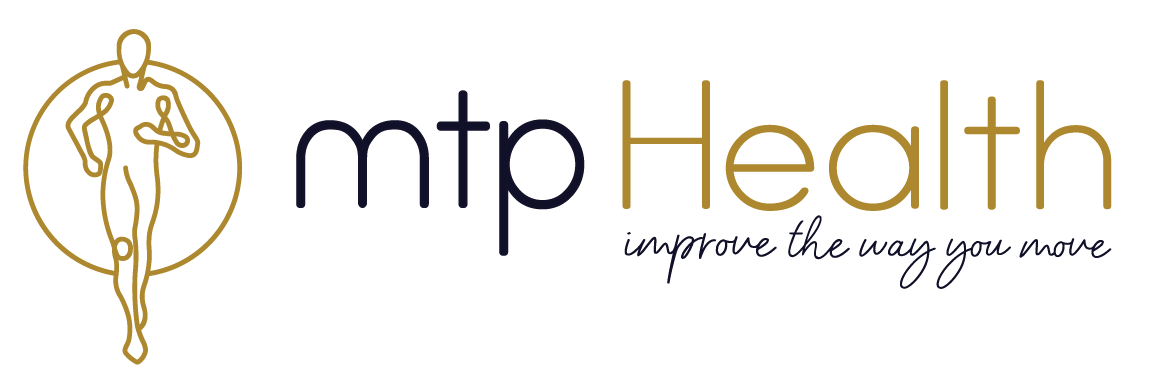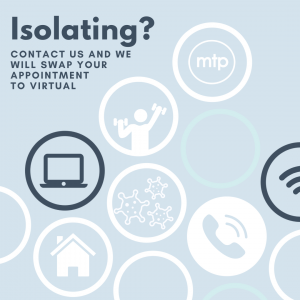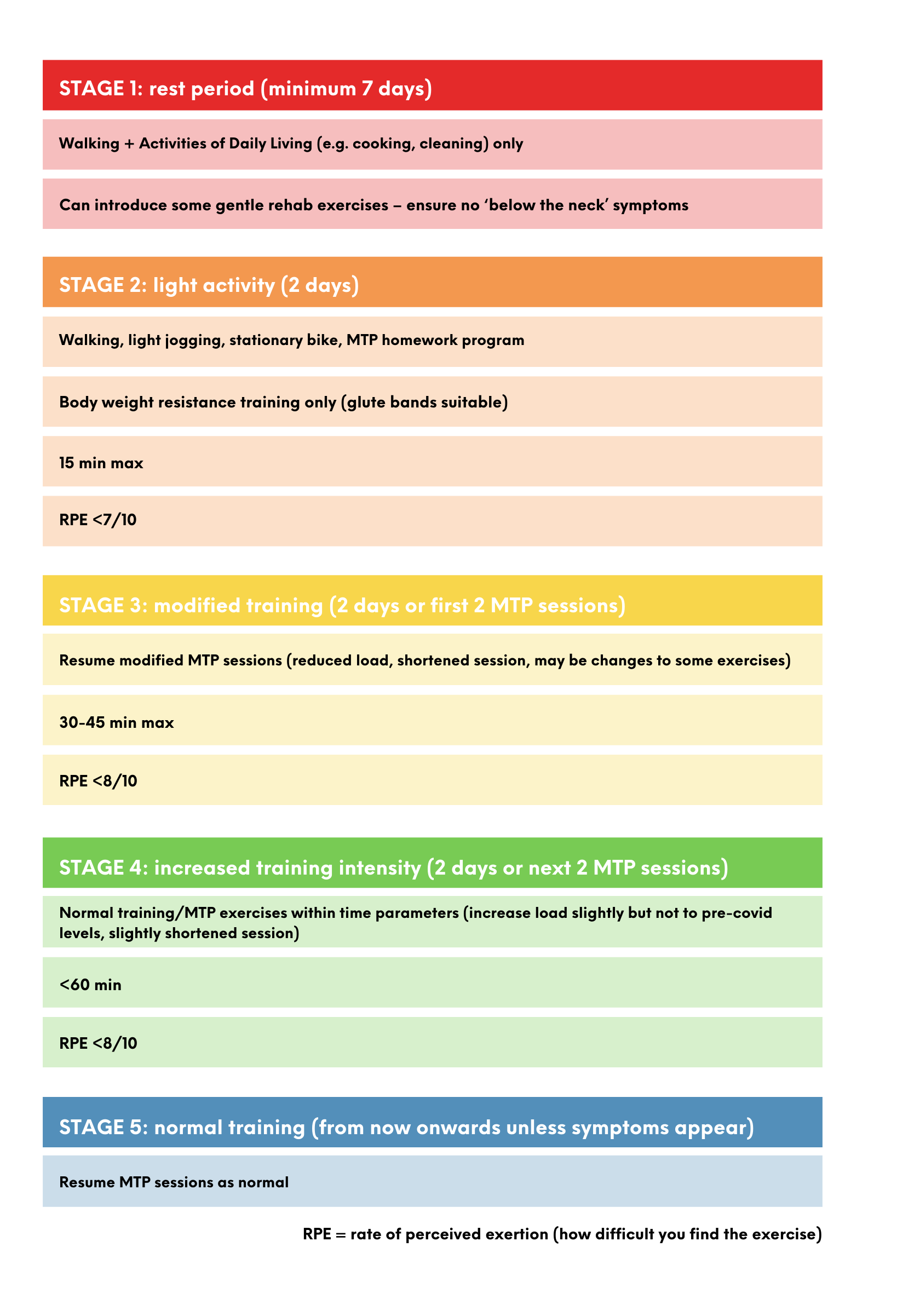Exercise and COVID-19: How Manage Isolation and Returning to Exercise
Covid-19 has posed many challenges to our community over the past 2 years. While grappling with disruptions to work and family arrangements, the impacts on our overall wellbeing and health have become apparent as we have been forced to abandon many of our essential strategies for coping – time with extended family and friends, vacations, enjoying performing arts, attending group therapies, exercise and courses. And as we continue learning to ‘live with’ covid we increasingly see the importance of maintaining our health through safe exercise.
Exercise during Covid isolation or illness: keeping up your rehab and conditioning when possible
Undergoing the minimum seven day isolation period is very likely to lead to deconditioning, which can slow your recovery or exacerbate pre-existing niggles or chronic conditions. Therefore, assuming the severity and type of symptoms you are experiencing are only mild, it is appropriate to undertake some light intensity activity throughout your isolation period. Not only will this assist in reducing physical decline you are likely to experience, but it has the ability to promote a better recovery.
It is recommended that if you have symptoms ‘above the neck’, including sneezing, minor sore throat and runny nose, it is suitable to undertake light exercise (Weiss, 2020). You can keep moving by going for walks around your backyard or home, which will assist with maintaining a level of aerobic conditioning, and may even have the effect of opening up your nasal passages to reduce congestion. Aiming for a short duration of 10-15 minutes maximum is a good starting point.
Importantly, this classification of light exercise includes gentle rehabilitation activities and gives you the opportunity to continue improving the way you move during isolation. Effective at home rehabilitation exercises are essential to maintaining muscle tone, movement patterning, and mobility – helping to prevent a return to painful joints. For example clients in our hip and knee programs, experiencing minor knee pain may benefit from doing banded glute activation, some movement patterning exercises, and low intensity strengthening exercises such as glute bridges, to facilitate blood flow to the area and introduce some movement at the joint. (Participants in our programs can let the team at MTP Health know they are isolating and their individual online programs adjusted to suit their isolation and illness circumstances.)
However, if you have ‘below the neck’ symptoms, which include fatigue, fever, stomach aches and body aches, bed rest is recommended until these symptoms subside (Weiss, 2020). Exercise should be postponed, particularly with fever as it is crucial you allow your body a few days to properly rest and recover.
Some people may see an exacerbation of symptoms related to their injury or pathology over the isolation period, whether it be from being regularly active to not moving at all, or for other reasons. Which leads to the next question: how and when to return to exercise if you have had to take a break?
Return to Exercise After Covid-19 illness
It can be hard to know when and how to return to exercise after have been unwell. With symptom severity ranging from mild to severe, where hospitalisation and intensive care may be required, it is important to undertake an appropriate gradual return to exercise based on your individual experience with the Covid-19 illness and in consultation with your healthcare team. However, with so many people experiencing covid, guidelines have been developed for those with mild to moderate experiences.

Guidelines for Returning to Higher Intensity Exercise
Below is a general guide for how to best return to training following Covid-19 infection. Please note that this guide is only applicable to those who have had mild to moderate illness. Those who required hospitalization or who have underlying health conditions which may put them at risk should have a further medical assessment to gain clearance prior to beginning a graded return to exercise. Be sure to consult your doctor and Exercise Physiologist for individualised guidance on returning to exercise following Covid-19.
It has been advised to only return to higher intensity training after a minimum of 7 days free of symptoms, whilst remaining at a relatively lower intensity for the first 2 weeks. As discussed above, it is suitable to introduce gentle activity of a light intensity prior to returning to your full rehabilitation program, permitted if your symptoms are not severe. If any symptoms (including shortness of breath, dizziness, rapid HR, excessive fatigue) return while going through the stages of this guide, you must return to the previous stage. Once you have had a minimum of 24 hours rest without symptoms, you can then progress to the next stage.
One way of measuring exercise intensity or how difficult you find the exercise is to measure your rate of perceived exertion (RPE) on a scale of 1-10. When going through stages 2-4 where modified training and slightly higher intensities are introduced, it is important to monitor the RPE you are working at to ensure you do not work above the recommended intensity. It is also a good idea to monitor your fatigue levels and muscle soreness during and after exercise – listening to your body is crucial in this time!
General guide on how to best return to training following Covid-19:
SOURCE: Infographic. Graduated return to play guidance following COVID-19 infection (Elliot et al., 2020)
Additional tips for Improving Recovery from Covid-19
Hydration + Nutrition
Aim to consume 2-3L (6-8 glasses) of water per day and maintain a balanced diet (5 servings of fruit/vegetables per day) to ensure the body consumes the essential nutrients which aid a quicker recovery.
Quality Sleep
Maintaining a good sleep routine, by aiming for 7-8 hours of good quality sleep per night, can assist your immune system function and benefit your mental health.
Allow time to Rest
Fatigue can be quite overpowering, so allow yourself enough time for the body to rest and then slowly get back into the swing of things, whether this relates to work or exercising.



Things to keep in mind as you manage your covid illness or isolation
Ensuring a gradual return to exercise after your symptoms subside is critical. This may require some patience, but the more careful you are with introducing exercise of the appropriate intensity and duration in the first weeks post-Covid-19 infection, the quicker your body will be able to tolerate pre-Covid exercise levels.
The most important thing is to listen to your body while you recover from Covid-19 in order to find the right balance between rest and physical activity. If you have any concerns or need additional assistance with your recovery, do not hesitate to contact your health care provider for their recommendation to assist in your return.
If in doubt, the best thing to do is ask your Exercise Physiologist for their recommendation on what you can do safely at home to maintain your overall wellbeing.
For more tips on how to recover well from Covid-19, access to a downloadable active recovery workbook, and additional useful information, go to https://australia.movingmedicine.ac.uk/covidrecovery/
Bibliography
Elliott, N., Martin, R., Heron, N., Elliott, J., Grimstead, D. and Biswas, A., 2020. Infographic. Graduated return to play guidance following COVID-19 infection. British Journal of Sports Medicine, 54(19), pp.1174-1175.
Salman, D., Vishnubala, D., Le Feuvre, P., Beaney, T., Korgaonkar, J., Majeed, A. and McGregor, A., 2021. Returning to physical activity after covid-19. BMJ, p.m4721.
Weiss, C., 2020. COVID-19: Exercise when ill; what’s okay and what’s not. [online] Available at: <https://newsnetwork.mayoclinic.org/discussion/covid-19-exercise-when-ill-whats-okay-and-whats-not/>



Great information and well written. Succinct and practical advice. Thanks